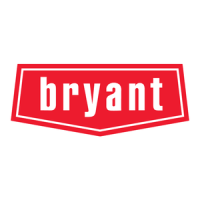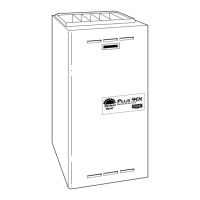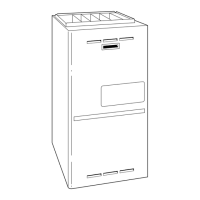50
(depending on selection at blower-OFF delay switches).
The furnace control CPU is factory-set for a 120-second
blower-OFF delay.
TWO-STAGE HEATING WITH TWO-STAGE
THERMOSTAT (NON-ADAPTIVE HEATING
MODE)
(See Fig. 32 and 50--56 for thermostat connections).
NOTE: In this mode, the low-heat only switch must be ON to
select the low-heat only operation mode in response to closing the
thermostat R-to-W1 circuit. Closing the thermostat R-to-W1
and-W2 circuits always causes high-heat operation, regardless of
the setting of the low-heat-only switch.
The wall thermostat “calls for heat”, closing the R to W1 circuit
for low-heat or closing the R to W1 and-W2 circuits for
high-heat. The furnace control performs a self-check, verifies the
low-heat and high-heat pressure switch contacts LPS and HPS are
open, and starts the inducer motor IDM in high-speed.
The start-up and shutdown functions and delays described in
item 1 above apply to 2-stage heating mode as well, except for
switching from low-to high-heat and vice versa.
1. Switching From Low- To High-Heat -- If the thermostat
R to W1 circuit is closed and the R to W2 circuit closes,
the furnace control CPU will switch the inducer motor
IDM speed from low to high. The high-heat pressure
switch relay HPSR is de-energized to close the NC
contact. When sufficient pressure is available the high-heat
pressure switch HPS closes, and the high-heat gas valve
solenoid GV-HI is energized. The blower motor BLWM
will switch to HI HT speed five seconds after the R to W2
circuit closes.
2. Switching From High-To Low-Heat -- If the thermostat R
to W2 circuit opens, and the R to W1 circuit remains
closed, the furnace control CPU will switch the inducer
motor IDM speed from high to low. The high-heat
pressure switch relay HPSR is energized to open the NC
contact and de-energize the high-heat gas valve solenoid
GV-HI. When the inducer motor IDM reduces pressure
sufficiently, the high-heat pressure switch HPS will open.
The gas valve solenoid GV-M will remain energized as
long as the low-heat pressure switch LPS remains closed.
The blower motor BLWM will switch to LO HT speed five
seconds after the R to W2 circuit opens.
COOLING MODE
The thermostat “calls for cooling”.
1. Single-Speed Cooling
(See Fig. 31, 50, 52, or 54 for thermostat connections.) The
thermostat closes R-to-G-and-Y circuits. The R-to-Y circuit
starts the outdoor unit, and R-to-G-and-Y/Y2 circuits start
the furnace blower motor BLWM on COOL speed. The elec-
tronic air cleaner terminal EAC-1 is energized with 115-v
when blower motor BLWM is operating.
When the thermostat is satisfied, the R-to-G-and-Y circuits
are opened. The outdoor unit will stop, and furnace blower
motor BLWM will continue operating on COOL speed for an
additional 90 sec. Jumper Y/Y2to DHUM to reduce the cool-
ing off-delay to 5 seconds. (See Fig. 37.)
2. Two-Speed Cooling and Single-Stage Thermostat
(Adaptive Mode)
(See Fig. 31 and 50--57 for thermostat connections.)
This furnace can operate a two-speed cooling unit with a
single-stage thermostat because the furnace control CPU
includes a programmed adaptive sequence of controlled
operation, which selects low-cooling or high-cooling
operation. This selection is based upon the stored history of
the length of previous cooling period of the single-stage
thermostat.
NOTE: The air conditioning relay disable jumper ACRDJ must
be connected to enable the adaptive cooling mode in response to
a call for cooling. (See Fig. 37.) When in place the furnace
control CPU can turn on the air conditioning relay ACR to
energize the Y/Y2 terminal and switch the outdoor unit to
high-cooling.
The furnace control CPU can start up the cooling unit in
either low-or high-cooling. If starting up in low-cooling,
the furnace control CPU determines the low-cooling
on-time (from 0 to 20 minutes) which is permitted before
switching to high-cooling.
If the power is interrupted, the stored history is erased and
the furnace control CPU will select low-cooling for up to
20 minutes and then energize the air conditioning relay
ACR to energize the Y/Y2 terminal and switch the outdoor
unit to high-cooling, as long as the thermostat continues to
call for cooling. Subsequent selection is based on stored
history of the thermostat cycle times.
The wall thermostat “calls for cooling”, closing the R to
G-and-Y circuits. The R to Y1 circuit starts the outdoor
unit on low-cooling speed, and the R to G-and-Y1 circuits
starts the furnace blower motor BLWM at low-cool speed
(same speed as LO HT).
If the furnace control CPU switches from low-cooling to
high-cooling, the furnace control CPU will energize the air
conditioning relay ACR. When the air conditioning relay
ACR is energized the R to Y1-and-Y2 circuits switch the
outdoor unit to high-cooling speed, and the R to
G-and-Y1-and-Y/Y2 circuits switch the furnace blower
motor BLWM to COOL speed.
NOTE: When transitioning from low-cooling to high-cooling the
outdoor unit compressor will shutdown for 1 minute while the
BLWM continues to run at low-cool speed (same speed as
LO-HT) until the outdoor unit compressor comes back on at high
speed.
The electronic air cleaner terminal EAC-1 is energized
with 115 vac whenever the blower motor BLWM is
operating. When the thermostat is satisfied, the R to
G-and-Y circuit are opened. The outdoor unit stops, and
the furnace blower BLWM and electronic air cleaner
terminal EAC-1 will remain energized for an additional 90
seconds. Jumper Y1 to DHUM to reduce the cooling
off-delay to 5 seconds. (See Fig. 37.)
3. Two-Speed Cooling and Two-Stage Thermostat
(See Fig. 32 and Fig. 50--57 for thermostat connections)
NOTE: The ACRDJ must be disconnected to allow thermostat
control of the outdoor unit staging. (See Fig. 37.)
The thermostat closes the R to G-and-Y1 circuits for low-
cooling or closes the R to G-and-Y1-and-Y2 circuits for
high-cooling. The R to Y1 circuit starts the outdoor unit on
low-cooling speed, and the R to G-and-Y1 circuit starts the
furnace blower motor BLWM on low-cool speed (same
speed as LO-HT).
The R-to-Y1-and-Y2 circuits start the outdoor unit on
high-cooling speed, and the R to G-and-Y/Y2 circuits start the
furnace blower motor BLWM on COOL speed.
The electronic air cleaner terminal EAC-1 is energized with
115 vac whenever the blower motor BLWM is operating.
When the thermostat is satisfied, the R-to-G-and-Y1 or R-to
G-and-Y1-and-Y2 circuits are opened. The outdoor unit stops,
and the furnace blower BLWM and electronic air cleaner terminal
EAC-1 will remain energized for an additional 90 seconds.
Jumper Y1 to DHUM to reduce the cooling off-delay to 5
seconds. (See Fig. 37.)
THERMIDISTAT MODE
(See Fig. 50--53 for Thermidistat connections.)
353BAV

